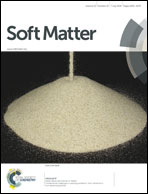Physicochemical characterization of partially hydrolyzed poly(vinyl acetate)–borate aqueous dispersions†
Abstract
The dynamic and structural properties of Highly Viscous Polymeric Dispersions (HVPDs), constituted of polyvinyl alcohol obtained from the 75% hydrolysis (75PVA) of polyvinlyl acetate (PVAc) cross-linked with borate ions, were studied as a function of the 75PVA concentration at a constant ratio between the OH groups and the borate ions (OH/B(OH)4−). The threshold 75PVA concentration C* necessary for the formation of the three-dimensional network was determined by flow rheology. The oscillating rheology measurements were performed in the linear viscoelastic region; the relaxation spectra calculated from the frequency sweep curves showed only one peak whose width increased upon increasing the 75PVA concentration due to the broadening of the relaxation modes. The dependence of the mean relaxation time τH upon the concentration of 75PVA followed a power law expression (τH ∼ Cx with x = 1.9) indicating that τH referred to a sticky reptation mechanism and that water was a good solvent for 75PVA as confirmed also by small angle X-rays scattering (SAXS) investigation. The HVPDs were used for the removal of grime layers from the surface of Carlo Carrà (1881–1966) paints decorating the walls of the Palazzo di Giustizia in Milan, Italy.


 Please wait while we load your content...
Please wait while we load your content...